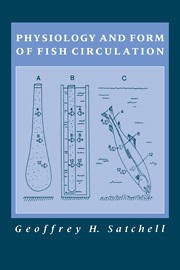Book contents
- Frontmatter
- Contents
- Preface
- 1 Introduction
- 2 The Heart
- 3 The peripheral circulation
- 4 The blood
- 5 Haemopoiesis and phagocytosis - the mononuclear phagocytic system
- 6 Circulation through special regions
- 7 Retial counter-current systems: flow–diffusion–concentration
- 8 Venous return and venous pumps
- 9 The autonomic nervous system
- 10 The response to exercise
- 11 The response to hypoxia
- 12 Myxine, a speculative conclusion
- References
- Appendix of popular and scientific names
- Index
9 - The autonomic nervous system
Published online by Cambridge University Press: 05 February 2012
- Frontmatter
- Contents
- Preface
- 1 Introduction
- 2 The Heart
- 3 The peripheral circulation
- 4 The blood
- 5 Haemopoiesis and phagocytosis - the mononuclear phagocytic system
- 6 Circulation through special regions
- 7 Retial counter-current systems: flow–diffusion–concentration
- 8 Venous return and venous pumps
- 9 The autonomic nervous system
- 10 The response to exercise
- 11 The response to hypoxia
- 12 Myxine, a speculative conclusion
- References
- Appendix of popular and scientific names
- Index
Summary
Introduction
A trout, during exercise, may increase its cardiac output threefold and augment the flow of blood to its red muscle from 1.14 to 16.21 ml min−1 kg−1 (Randall and Daxboeck 1982). In Chapter 2 we saw that a greater return of blood to the heart will increase its output, through the Starling law, and in Chapter 3, hyperaemia, which increases the flow of blood to active tissues, was described. The greater pressure in the efferent branchial arteries that occurs during exercise may in turn increase the surface area perfused with blood of individual gill lamellae; it may also recruit additional lamellae into the circulation. Both of these responses can be exspected to increase the ability of the gills to take up oxygen.
All four mechanisms are intrinsic to the tissues, cardiac muscle, or vascular smooth muscle, which respond in these ways, and they help to maintain an adequate circulation under a variety of external conditions. Such mechanisms were, presumably, sufficient on their own in ancestral vertebrates. In hagfish they must be particularly important because there is no autonomic innervation of the heart; blood vessels too are minimally innervated if at all and there are no innervated central stores of catecholamines.
In more active fish the demands of different organs and tissues may, however, be in conflict. The heart may be unable to supply sufficient blood to the skeletal muscles unless the flow to the gut and other viscera is temporarily curtailed. Under conditions of severe hypoxia the skeletal muscles may prove to be better able to endure a spell of glycolysis than the brain or the retina.
- Type
- Chapter
- Information
- Physiology and Form of Fish Circulation , pp. 141 - 157Publisher: Cambridge University PressPrint publication year: 1991
- 1
- Cited by



